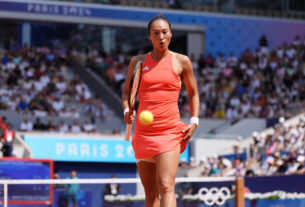U.S Soccer has taken the decision to part ways with Gregg Berhalter after the United States men’s national team’s disappointing showing at the Copa America on home soil.
The team finished third in their group, with Uruguay and Panama advancing to the knockout stage. With only two years to go until the U.S. co-hosts the World Cup, they have decided to make a change.

GO DEEPER
USMNT had questions before its Copa America exit. Now those get even louder
There are plenty of high-profile foreign managers on the market — not least Jurgen Klopp after he left Liverpool this summer — as the U.S. Soccer Federation (USSF) looks to appoint Berhalter’s successor.
“I think now we’re in a better place to have much more of a targeted search where I’ll be more inclined to go hard and go early with specific candidates that I feel meet the criteria that we’re looking for,” said U.S. Soccer’s sporting director Matt Crocker.
Asked if speaking English was still a criteria for the position, Crocker said: “I think effective communication is critical when you need to get a message across to the players. That hasn’t changed. And we’ll be considering a really wide pool of candidates. I’m already on that straightaway. Our intention is to continue with that process.”
Here are some of the possible candidates to replace Berhalter, and the style of football they might bring to the USMNT set-up. Who would you like to see take over?
Jurgen Klopp
Jurgen Klopp favours a high defensive line and a high press designed to win the ball back at the earliest opportunity when possession is lost — as shown by The Athletic’s playstyle wheel below, which outlines how a team look to play compared with Europe’s top seven domestic leagues.
It’s high risk, high reward — always playing on the front foot, always trying to seize the initiative. Caution is not a word in the 57-year-old’s vocabulary. Looking at their “Patient attack” metric below (23 out of 99), it’s clear Klopp likes his side to go for the throat and punish the opposition as soon as possible.

Klopp would be a breath of fresh air tactically and man-management wise, he’s already proven he can get the best out of talent across the board — fostering a sense of unity and togetherness.
The USMNT’s roster could appeal to him too. Take, for example, the blistering attack which won so many plaudits at Anfield. Klopp’s Liverpool were at their best with a high-energy, hard-running front three, and attackers such as Christian Pulisic, Folarin Balogun and Ricardo Pepi could, in theory at least, be appealing to the German.
With all those players, and indeed most of the USMNT’s main men, playing in Europe, Klopp would also be familiar with their leagues and the tactical systems they operate under at clubs.
Gareth Southgate
Gareth Southgate has overseen a transformation of England’s reputation since he took the role as national team manager in 2016.
While fans might have grown frustrated by Southgate’s lack of tactical invention with such a talented squad of players, the 53-year-old has shown a ruthlessness to his character in recent months — most notably leaving the experienced Jordan Henderson and Marcus Rashford from his long list of 33 players for the European Championship.

(Carl Recine/Getty Images)
While Southgate has favoured a back four system in recent years, he has shown flexibility in adapting to a back three — often as a counter-measure to the opposition setup, as shown in England’s matches against Switzerland and Netherlands as they reached the Euro 2024 final.

International football is tactically and qualitatively different from club football, meaning the remit is less about the day-to-day coaching and more about the long-term vision of the national team. Southgate may have been criticised for his tactical acumen at times, but his near-ambassadorial presence is a valuable asset that should not be underestimated at international level.
Neither should his willingness to take qualified risks with gifted but inexperienced players. Kobbie Mainoo, 19, and Adam Wharton, 20, were included in his current squad on the adage that they were good enough and so old enough, and Americans such as the 20-year-old Chelsea goalkeeper Gaga Slonina might feel their prospects of a World Cup spot increase. So too may 14-year-old Manchester City-bound prodigy Cavan Sullivan, who will be the same age as Spain’s Lamine Yamal is now when the 2026 tournament begins.
Mauricio Pochettino
Mauricio Pochettino’s preferred style is grounded in high intensity and pressing, and Chelsea’s numbers for last season point to a side that did not step off when out of possession (intensity: 89 out of 99).

Issues in both penalty boxes were a key narrative of Chelsea’s season under Pochettino. Their underlying chance creation (83 out of 99) was strong, but it seemed to come at the expense of a dreadfully poor defensive record (chance prevention: 32 out of 99). Chelsea’s 1.4 non-penalty expected goals conceded per 90 minutes invariably gave them a mountain to climb in each match, and Pochettino struggled to find that balance for a lot of the season.
As unglamorous as it may sound, international football is grounded in having strong defensive foundations first and Pochettino did not showcase that in his most recent time in the dugout.
Such shortcomings would naturally put more focus on the individual quality of the back line and goalkeeper; areas where the current U.S. roster has its problems. Goalkeeper Matt Turner barely played for Nottingham Forest last season and his kicking and distribution were at times questionable at the Copa America. Behind him, Ethan Horvath is a step down in quality again and conceded a poor goal when forced into action after Turner’s injury against Panama.
Then there is a shortage of obvious candidates to replace ageing centre-back Tim Ream and doubts over the strength in depth behind him and Chris Richards. At Chelsea, Pochettino arguably had better defenders and they still struggled.
Thomas Tuchel
Despite a disappointing season relative to Bayern Munich’s standards, the underlying numbers from Tuchel’s side show how dominant they have still been in both boxes. Competing with a history-making, invincible Bayer Leverkusen side was not part of the plan, but Bayern’s 1.6 xG difference per 90 — which accounts for the quality of chances created and conceded — was the best of any side across Europe’s top five leagues.

Tuchel’s tactical acumen is undeniable, but question marks over his temperament might be a factor that works against him. Across his three most recent roles at Paris Saint-Germain, Chelsea and Bayern Munich, he averaged a tenure of one year, nine months and 15 days. International football is different, of course, but if the USMNT is looking for a long-term vision, Tuchel might not be the best man. He is, however, available after leaving Bayern and meeting Manchester United earlier this summer.

Tuchel celebrates winning the Champions League with Chelsea in May 2021 (Marc Atkins/Getty Images)
There may also be the thorny issue of what Pulisic would make of a Tuchel appointment. The pair worked together at Stamford Bridge and it became clear it was, at times, a strained relationship, with the U.S. captain admitting he was “dumbfounded” at being dropped for a Champions League semi-final in 2021.
Thomas Frank
Thomas Frank, 50, would bring a clear tactical philosophy. His 5-3-2 formation is combative, disciplined, and a nightmare to play against. In the past three seasons, only Brighton have taken more than Brentford’s 35 points against the ‘Big Six’ in the Premier League, with the west London side securing two wins over Manchester City, three over Chelsea, and a 4-0 thrashing of Manchester United.
Equally, his ability to shift his side to a 4-3-3 across the season shows a tactical versatility that would be highly suited to international football, where maximising the strengths of the players at your disposal is paramount.

The fact that Frank has overseen Brentford’s rise into the Premier League for the first time and has now kept them there for three consecutive seasons speaks to the transformative job he has performed. He is an experienced coach and a good motivator boasting long-term success.
He has also spoken of being open to possibilities and this would represent an exciting new one for the personable Dane. His likability and ability to build morale could be welcomed by the U.S. players — especially those, like Gio Reyna, who have at times clashed with Berhalter.

(Eddie Keogh/Getty Images)
Ralf Rangnick
As the Godfather of gegenpressing, you know what you are going to get with a Ralf Rangnick team. His high-energy, relentless approach has inspired so many coaches who have worked with him, and when asked to describe his playing philosophy during a recent interview for The Coaches’ Voice, the German said, “It’s a high-pressing, counter-pressing football. I would say fast, proactive, attacking, counter-attacking, counter-pressing and exciting.”
Anyone doubting Rangnick’s ability to instil such methods at international level need only to look at Austria’s out-of-possession approach during Euro 2024 this summer. Their 10.1 passes allowed per defensive action (PPDA) — a metric where a lower number denotes a more active pressing approach — shows them to be the most intense pressers of any side in the tournament.

In possession, Rangnick is a believer in possession with a purpose. Where possible, look to pass it forward, and limit those square or backward passes that slow the game down. Fans of New York Red Bulls under Jesse Marsch will be highly familiar with this style, with Marsch a staunch advocate of Rangnick’s gung-ho method of attack.
The U.S. have individuals, such as Pulisic and, at his best, Reyna, who can make things happen while also being athletic enough to press hard in the Rangnick style.
The 66-year-old has experience in international management, having been in charge of Austria for two years.
Patrick Vieira
While Patrick Vieira’s RC Strasbourg finished 13th in Ligue 1 last season, the 48-year-old recently shared his lofty targets for the future.

Vieira was unveiled at Strasbourg in July 2023 (Frederick Florin/AFP via Getty Images)
“The ambition is to play European football in the next three years,” Vieira said on the Stick to Football podcast. “Of course, coming from this year, there is a big turn of young players, and this year was challenging and difficult — we struggled and went through some difficult periods.”
Vieira favours a considered, possession-dominant style of football, but he has rarely had the players to implement it. At Crystal Palace, he had to compromise those plans for an attritional, counter-attacking approach which saw Vieira sacked after a 12-game winless run.
Strasbourg’s playing style looks similarly confused, as Vieira encourages his team to circulate the ball when they have it (82 out of 99) — even if those opportunities are rare (Possession, 17 out of 99) — but his side often lacked the bite at the top end of the field (Chance creation, 41 out of 99).

Vieira’s experience coaching NYCFC in MLS would be a useful headstart to acclimatise to U.S. soccer, but his recent roles have shown that he is still a developing manager compared with the other candidates on the list.
It is in his old position, central midfield, where the current roster is stocked with talent. Younger prospects such as Real Betis’ Johnny Cardoso and Malik Tillman could learn from one of the best-ever in that role. At the same time, the more experienced trio of Pulisic, Weston McKennie and Tim Weah would have a manager who knows exactly what it is like to play in two of Italy’s biggest clubs, AC Milan and Juventus. The USMNT has tried great players as coach before (see Jurgen Klinsmann) to differing effect but Vieira’s CV is among the best.
A World Cup winner in charge for the next World Cup would have to be a potential plus.
(Top photos: Getty Images)





